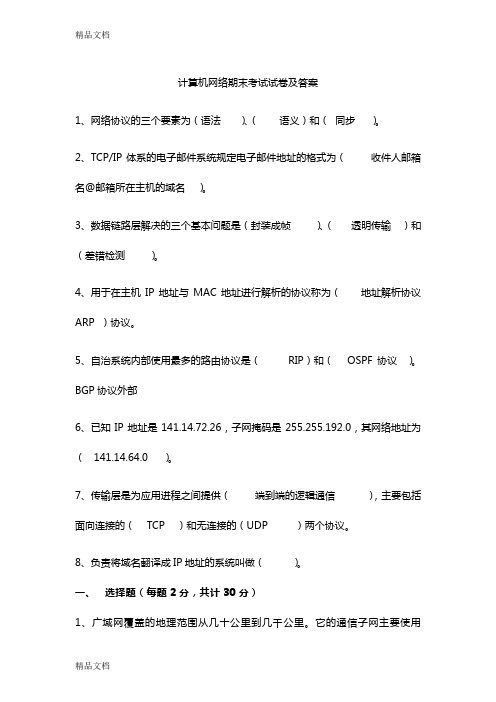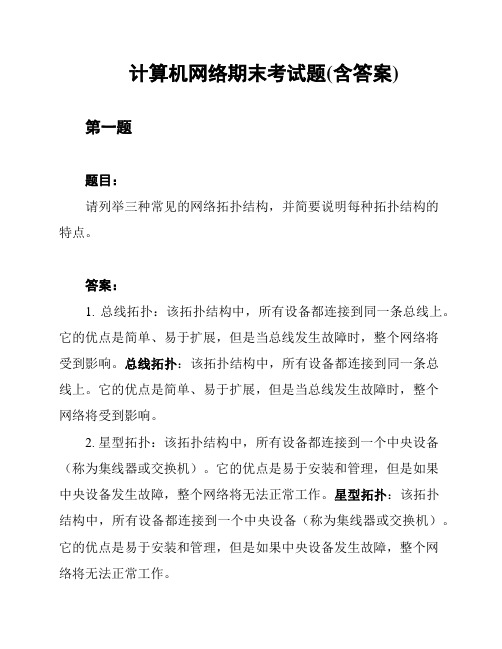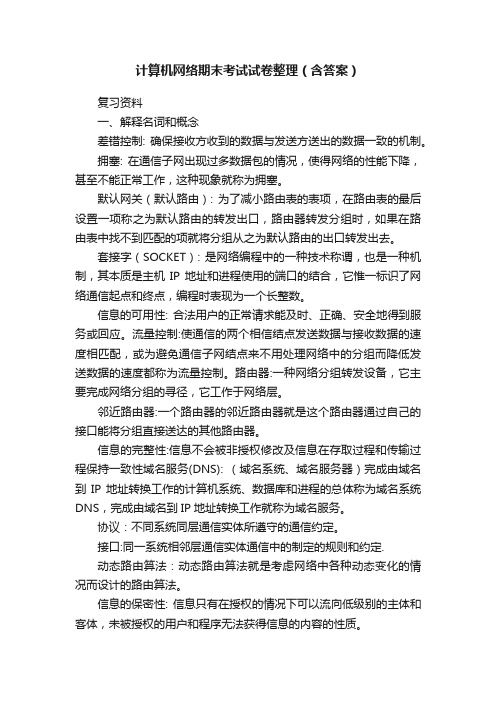天津理工大学计算机网络期末考试复习提纲带答案
大学生计算机科学期末考试复习题及参考答案

大学生计算机科学期末考试复习题及参考答案题目一请解释什么是计算机网络?参考答案:计算机网络是将多台计算机通过通信设备(如路由器、交换机)连接而成的网络系统。
它允许计算机之间进行数据传输和资源共享。
计算机网络是将多台计算机通过通信设备(如路由器、交换机)连接而成的网络系统。
它允许计算机之间进行数据传输和资源共享。
题目二列举并简要解释五种常见的计算机网络协议。
参考答案:1. TCP/IP协议:TCP/IP协议是互联网的核心协议,它包含两个部分:传输控制协议(TCP)和Internet协议(IP)。
TCP负责确保数据可靠传输,而IP负责将数据包进行路由和寻址。
4. SMTP协议:SMTP协议是用于发送电子邮件的协议。
它定义了电子邮件的传输规则和信封格式。
5. DNS协议:DNS协议是用于将域名解析为IP地址的协议。
它提供了域名与IP地址之间的映射功能。
题目三什么是网络攻击?列举并简要解释三种常见的网络攻击类型。
参考答案:网络攻击是指对计算机网络进行恶意、非法的活动,旨在破坏网络的正常运行或获取非法利益。
网络攻击是指对计算机网络进行恶意、非法的活动,旨在破坏网络的正常运行或获取非法利益。
1. DDos攻击:DDoS攻击是通过利用大量恶意流量淹没目标服务器或网络资源,从而使其无法正常工作。
2. Phishing攻击:Phishing攻击是通过伪装成合法的通信或网站,欺骗用户提供敏感信息(如密码、信用卡号),以获取个人或财务利益。
3. 病毒攻击:病毒攻击是指通过恶意软件感染计算机系统,从而破坏、篡改或窃取数据。
题目四请简要介绍三种常见的网络安全防护机制。
参考答案:1. 防火墙:防火墙是位于网络之间的一道安全屏障,用于监控和控制网络流量。
它可以过滤恶意流量,阻止未经授权的访问。
2. 加密技术:加密技术可以将敏感数据转化为密文,以保护数据在传输和存储过程中的安全性。
常见的加密算法包括AES、RSA 等。
3. 安全认证与访问控制:安全认证和访问控制是通过识别和验证用户身份,并根据其权限控制其对网络资源的访问。
计算机网络期末考试试卷及答案备课讲稿

计算机网络期末考试试卷及答案1、网络协议的三个要素为(语法)、(语义)和(同步)。
2、TCP/IP 体系的电子邮件系统规定电子邮件地址的格式为(收件人邮箱名@邮箱所在主机的域名)。
3、数据链路层解决的三个基本问题是(封装成帧)、(透明传输)和(差错检测)。
4、用于在主机IP地址与MAC地址进行解析的协议称为(地址解析协议ARP )协议。
5、自治系统内部使用最多的路由协议是(RIP)和(OSPF 协议)。
BGP协议外部6、已知IP地址是141.14.72.26,子网掩码是255.255.192.0,其网络地址为( 141.14.64.0 )。
7、传输层是为应用进程之间提供(端到端的逻辑通信),主要包括面向连接的( TCP )和无连接的(UDP )两个协议。
8、负责将域名翻译成IP地址的系统叫做()。
一、选择题(每题2分,共计30分)1、广域网覆盖的地理范围从几十公里到几千公里。
它的通信子网主要使用( B )A、报文交换技术B、分组交换技术C、文件交换技术D、电路交换技术2、数据链路层中的数据块常被称为( C )A、信息B、分组C、帧D、比特流3、关于TCP/IP的IP层协议描述不正确的是( D )A、是点到点的协议B、不能保证IP报文的可靠传送C、是无连接的数据报传输机制D、每一个IP数据包都需要对方应答4、以下哪项不是IP路由器应具备的主要功能(C )A、转发所收到的IP数据报B、为需要转发的IP数据报选择最佳路径C、分析IP数据报所携带的TCP内容D、维护路由表信息5、用集线器连接的工作站集合( A )A、同属一个冲突域,也同属一个广播域B、不属一个冲突域,但同属一个广播域C、不属一个冲突域,也不属一个广播域D、同属一个冲突域,但不属一个广播域6、标准TCP不支持的功能是( D )。
A、可靠数据传输B、全双工通信C、流量控制和拥塞控制D、组播通信7、IP地址为224.0.0.11属于( D)地址。
计算机网络期末考试题(含答案)

计算机网络期末考试题(含答案)第一题题目:请列举三种常见的网络拓扑结构,并简要说明每种拓扑结构的特点。
答案:1. 总线拓扑:该拓扑结构中,所有设备都连接到同一条总线上。
它的优点是简单、易于扩展,但是当总线发生故障时,整个网络将受到影响。
总线拓扑:该拓扑结构中,所有设备都连接到同一条总线上。
它的优点是简单、易于扩展,但是当总线发生故障时,整个网络将受到影响。
2. 星型拓扑:该拓扑结构中,所有设备都连接到一个中央设备(称为集线器或交换机)。
它的优点是易于安装和管理,但是如果中央设备发生故障,整个网络将无法正常工作。
星型拓扑:该拓扑结构中,所有设备都连接到一个中央设备(称为集线器或交换机)。
它的优点是易于安装和管理,但是如果中央设备发生故障,整个网络将无法正常工作。
3. 环型拓扑:该拓扑结构中,所有设备通过一个环形链路连接。
它的优点是每个设备都具有平等的通信权限,但是当环路中的一个设备发生故障,整个网络将被切断。
环型拓扑:该拓扑结构中,所有设备通过一个环形链路连接。
它的优点是每个设备都具有平等的通信权限,但是当环路中的一个设备发生故障,整个网络将被切断。
第二题题目:简要解释TCP/IP协议族中的三次握手过程。
答案:TCP/IP协议族中的三次握手过程用于建立可靠的数据传输连接。
1. 第一次握手:客户端向服务器发送一个SYN段(同步序列编号),用于请求建立连接。
客户端会将自己的初始序列号随机选择,并设置SYN标志位为1。
第一次握手:客户端向服务器发送一个SYN段(同步序列编号),用于请求建立连接。
客户端会将自己的初始序列号随机选择,并设置SYN标志位为1。
2. 第二次握手:服务器接收到客户端的SYN段后,确认请求建立连接,并发送一个带有SYN和ACK(确认)标志位的段作为响应。
服务器要在该段中将客户端的初始序列号+1,并设置自己的初始序列号。
第二次握手:服务器接收到客户端的SYN段后,确认请求建立连接,并发送一个带有SYN和ACK(确认)标志位的段作为响应。
计算机网络期末考试试卷整理(含答案)

计算机网络期末考试试卷整理(含答案)复习资料一、解释名词和概念差错控制: 确保接收方收到的数据与发送方送出的数据一致的机制。
拥塞: 在通信子网出现过多数据包的情况,使得网络的性能下降,甚至不能正常工作,这种现象就称为拥塞。
默认网关(默认路由): 为了减小路由表的表项,在路由表的最后设置一项称之为默认路由的转发出口,路由器转发分组时,如果在路由表中找不到匹配的项就将分组从之为默认路由的出口转发出去。
套接字(SOCKET): 是网络编程中的一种技术称谓,也是一种机制,其本质是主机IP地址和进程使用的端口的结合,它惟一标识了网络通信起点和终点,编程时表现为一个长整数。
信息的可用性: 合法用户的正常请求能及时、正确、安全地得到服务或回应。
流量控制:使通信的两个相信结点发送数据与接收数据的速度相匹配,或为避免通信子网结点来不用处理网络中的分组而降低发送数据的速度都称为流量控制。
路由器:一种网络分组转发设备,它主要完成网络分组的寻径,它工作于网络层。
邻近路由器:一个路由器的邻近路由器就是这个路由器通过自己的接口能将分组直接送达的其他路由器。
信息的完整性:信息不会被非授权修改及信息在存取过程和传输过程保持一致性域名服务(DNS): (域名系统、域名服务器)完成由域名到IP地址转换工作的计算机系统、数据库和进程的总体称为域名系统DNS,完成由域名到IP地址转换工作就称为域名服务。
协议:不同系统同层通信实体所遵守的通信约定。
接口:同一系统相邻层通信实体通信中的制定的规则和约定.动态路由算法:动态路由算法就是考虑网络中各种动态变化的情况而设计的路由算法。
信息的保密性: 信息只有在授权的情况下可以流向低级别的主体和客体,未被授权的用户和程序无法获得信息的内容的性质。
动态主机配置协议(DHCP): 用于动态配置网络中主机的IP地址、网络掩码、默认网关和DNS等参数。
FTP:文件传输协议。
它是一个应用层的协议。
多路复用: 将一条物理的信道或逻辑信道分为多条逻辑信道使用。
计算机网络期末考试学习的试题及答案

精选文档计算机网络期末考试一试题及答案填空题〔每空1分,共30分〕1、在计算机网络的定义中,一个计算机网络包含多台拥有自治_功能的计算机;把众多计算机有机连结起来要依据规定的商定和规那么,即通信协议;计算机网络的最根本特色是__资源共享_______。
2、常有的计算机网络拓扑构造有:总线型、星型和网状3、常用的传输介质有两类:有线和无线。
有线介质有双绞线、同轴电缆、光纤。
4、网络按覆盖的范围可分为广域网、_城域网、局域网。
5、TCP/IP协议参照模型共分了___4层,此中3、4层是传输层、应用层。
6、电子邮件系统供给的是一种_储存转发式_________效力,WWW效力模式为___B/S7、B类IP地点的范围是—8、当前无线局域网采纳的拓扑构造主要有__点对点方式__、_多点方式_______、_______中继方式____。
9、计算机网络的根安分类方法主要有:依据网络所覆盖的范围、依据网络上主机的组网方式,另一种是依据信息互换方式_。
10、数据传输的同步技术有两种:___同步传输_________和异步传输。
11、用双绞线连结两台互换机,采纳交错_线。
586B的标准线序是橙白、橙、白绿、蓝、蓝白、绿、棕白、棕_。
12、多路复用技术是使多路信号共同使用一条线路进行传输,或许将多路信号组合在一条物理信道上传输,以充足利用信道的容量。
多路复用分为:频分多路复用 _、波分多路复用_、时分多路复用和码分多路复用13、VLAN〔虚构局域网〕是一种将局域网从逻辑区分网段,而不是从物理_上区分网段,进而实现虚构工作组的新兴数据互换技术。
二、选择题〔每题2分,共30分〕14、计算机网络拓扑是经过网中结点与通信线路之间的几何关系表示网络中各实体间的____B_____。
A、联机关系B、构造关系C、主次关系D、层次关系15、双绞线由两根相互绝缘的、绞合成平均的螺纹状的导线构成,以下对于双绞线的表达,不正确的选项是_A____。
计算机网络期末考试题及答案

计算机网络期末考试题及答案题一:计算机网络基础知识1. 什么是计算机网络?简要描述其作用和特点。
计算机网络是指将分布在不同地理位置的计算机系统通过通信线路连接起来,以实现信息的传输和资源共享的系统。
计算机网络的主要作用是实现计算机之间的数据传输、信息共享和通信,以及提供可靠的通信服务和共享计算机资源。
其特点包括分布性、共享性、可靠性和可扩展性。
2. 请简要说明计算机网络分层模型的作用,并列举常见的分层模型。
分层模型将计算机网络的功能划分为多个相互独立的层次,每个层次对上一层提供服务,对下一层请求服务,便于网络的设计、实施和管理。
常见的分层模型有OSI参考模型和TCP/IP模型。
3. OSI参考模型包含哪些主要的七层?OSI参考模型主要包括物理层、数据链路层、网络层、传输层、会话层、表示层和应用层。
4. 传输层的主要功能是什么?列举常见的传输层协议。
传输层主要负责对上一层(应用层)提供可靠的端到端的数据传输服务,确保数据的完整性和可靠性。
常见的传输层协议包括TCP(传输控制协议)和UDP(用户数据报协议)。
5. 简要描述IP协议的功能和特点。
IP协议是网络层的核心协议,负责将数据包从源主机传输到目标主机。
其主要功能包括寻址和路由选择。
IP协议的特点包括无连接、不可靠和分组交换。
6. TCP协议和UDP协议有什么区别?在什么情况下更适合使用TCP或UDP?TCP协议提供可靠的,面向连接的数据传输,利用序列号和确认机制确保数据的可靠性,适合于需要数据完整性和可靠性的应用场景,如文件传输、电子邮件等。
UDP协议提供无连接的数据传输,不保证数据的可靠性,适合于实时性要求较高,对数据可靠性要求较低的应用场景,如音频、视频流等。
题二:网络安全与管理1. 什么是网络攻击?列举常见的网络攻击类型。
网络攻击指的是对计算机网络进行非法访问、破坏或控制的行为。
常见的网络攻击类型包括DDoS攻击、黑客攻击、病毒和恶意软件攻击、拒绝服务攻击等。
计算机网络__期末试题答案
计算机网络期末考试卷一答案仅供参考一、选择题1.网络的根本分类有两种:一种是根据网络所使用的传输技术,另一种是〔C 〕A 网络协议B 网络的拓扑构造C 覆盖围与规模D 网络效劳的操作系统2.传输层向用户提供〔 B 〕A 链路层B 端对端层C 网络对网络D 子网到子网3.下面IP属于D类地址的是〔 C 〕A 10.10.5.168B 168.10.0.14.通信信道的每一端可以是发送端,也可以是承受端,信息可由这一端传输到另一端,也可以从那一端传输到这一端,但是在同一时刻,信息只能有一个传输的通信方式为〔B 〕A单工通信B半双工C全双工D模拟5.将数据从FTP户传输FTP效劳器上,称为〔B 〕A 数据下载B 数据上传C宽带连接D FTP效劳6.ADSL技术主要解决的问题是〔B 〕A 宽带传输B宽带接入C 宽带交换D 多媒体技术7.常用的数据传输率单位有Fbps,Mbps.Gbps,如果广域网传输速率为100Mbps,则发送1Bit数据需要时间是〔 C 〕8.计算机网络拓扑构造是通过网中结点与通信线路之间的集合关系来表示网络构造,它反映出网络中各实体的〔A 〕A 构造关系B 主从关系C 接口关系D 层次关系9.以下说确的是〔 B 〕A 采用虚拟网络技术,网络中的逻辑工作组的结点组成不受结点所在的物理位置限制B 采用虚拟网络技术,网络中的逻辑工作组的结点组成受结点所在的物理位置限制C采用虚拟网络技术,网络中的逻辑工作组的结点必须在同一网段上D 全错10.FDDI采用〔B 〕构造A 单环B双环C 三环D 四环11.以下哪个是MAC地址〔B〕12.CSMALCD介质控制方法的局域网适用于办公自动化环境,这类局域网在何种网络通信负荷〔D 〕情况下表现出较好的吞吐率和延迟。
A 高B 低C中等D 不限定13.决定使用哪条路径通道子网,应属于以下OSI的〔D〕处理。
A物理层B数据链路层C传输层D网络层14.在数据通信中使用曼彻斯偏码主要原因是〔B 〕。
2022年天津理工大学网络工程专业《计算机网络》科目期末试卷A(有答案)
2022年天津理工大学网络工程专业《计算机网络》科目期末试卷A(有答案)一、选择题1、TCP/IP模型中的网络接口层对应OSI参考模型的()。
I.物理层Ⅱ.数据链路层Ⅲ.网络层Ⅳ.传输层A. I、IIB. II、III.C. I、ⅢD.Ⅱ、Ⅳ2、()是计算机网络中的OSI参考模型的3个主要概念。
A.服务、接口、协议B.结构、模型、交换C.子网、层次、端口D.广域网、城域网、局域网3、下面有关BGP4的描述中,不正确的是()。
A.BGP4是自治系统之间的路由协议B.BGP4不支持CIDR技术C.BGP4加入路由表的路由并不一定是最佳路由D.BGP4封装在TCP段中传送4、在IP首部的字段中,与分片和重组无关的是()。
注:假设现在已经分片完成。
A.总长度B.标识C.标志D.片偏移5、信道速率为4kbit/s,采用停止-等待协议。
传播时延t=20ms,确认帧长度和处理时间均可忽略。
问帧长()才能使信道的利用率达到至少50%。
A.40bitB.80bitC.160bitD.320bit6、下列关于交换机的叙述中,正确的是()A.以太网交换机本质上是一种多端口网桥B.通过交换机互连的一组工作站构成一个冲突域C.交换机每个端口所连网络构成一个独立的广播域D.以太网交换机可实现采用不同网络层协议的网络互连7、一个UDP用户数据报的数据字段为8192B。
在链路层要使用以太网来传输,那么应该分成()IP数据片。
A.3个B.4个C.5个D.6个8、假设某时刻接收端收到有差错的UDP用户数据报,其动作为()。
A.将其丢弃B.请求重传C.纠错D.忽略差错9、如果用户程序使用UDP进行数据传输,那么()协议必须承担可靠性方面的全部工作。
A.数据链路层B.网络层C.传输层D.应用层10、当客户端请求域名解析时,如果本地DNS服务器不能完成解析,就把请求发送给其他服务器,当某个服务器知道了需要解析的IP地址,把域名解析结果按原路返回给本地DNS服务器,本地DNS服务器再告诉客户端,这种方式称为()。
2022年天津大学计算机网络技术专业《计算机网络》科目期末试卷A(有答案)
2022年天津大学计算机网络技术专业《计算机网络》科目期末试卷A(有答案)一、选择题1、在OS1参考模型中,下列功能需由应用层的相邻层实现的是()。
A.对话管理B.数据格式转换C.路由选择D.可靠数据传输2、()属于TCP/IP协议簇的应用层应用服务元素。
A.文件传输协议FTPB.用户数据报协议UDPC.控制报文协议ICMPD.地址解析协议ARP3、在TCP中,采用()来区分不同的应用进程。
A.端口号B.IP地址C.协议类型D.MAC地址4、传输层为()之间提供逻辑通信。
A.主机B.进程C.路由器D.操作系统5、流量控制是为防止()所需要的。
A.位错误B.发送方缓冲区溢出C.接收方缓冲区溢出D.接收方与发送方间冲突6、CSMA协议可以利用多种监听算法来减小发送冲突的概率,下列关于各种监听算法的描述中,正确的是()。
A.非坚持型监听算法有利于减少网络空闲时间B.1-坚持型监听算法有利于减少冲突的概率C.P-坚持型监听算法无法减少网络的空闲时间D.1-坚持型监听算法能够及时抢占信道7、若某通信链路的数据传输速率为2400bit/s,采用4相位调制,则该链路的波特率是()A.600BaudB.1200BaudC.4800BaudD.9600Baud8、在图所示的采用“存储-转发”方式分组的交换网络中所有链路的数据传输速率为100Mbit/s,分组大小为1000B,其中分组头大小为20B。
若主机H1向主机H2发送一个大小为980 000B的文件,则在不考虑分组拆装时间和传播延迟的情况下,从H1发送到H2接收完为止,需要的时间至少是()A.80msB.80.08msC.80.16msD.80.24ms9、在物理层接口特性中,用于描述完成每种功能的事件发生顺序的是()。
A.机械特性B.功能特性C.过程特性D.电气特性10、图中,若主机H2向主机H4发送1个数据帧,主机H4向主机H2立即发送1个确认帧,则除H4外,从物理层上能够收到该确认帧的主机还有().A.仪H2B.仅H3C.仅H1,H2D. 仅H2、H311、某局域网采用SNMP进行网络管理,所有被管设备在15min内轮询一次,网络没有明显拥塞,单个轮询时间为0.4s,则该管理站最多可支持()个设备。
天津理工大学计算机网络期末考试复习提纲带答案
单选题/填空题:1. CIDR address 无类域间路由地址(P227-229)2. UDP 用户数据报协议(P132-135)3. TCP retransmission TCP重传(P163-167, 3.5.4)4. IP address header length IP地址首部长度(40 bytes)5. IP header field IP地址首部(P221-225)6. network edge and network core 网络边缘与网络核心(P6-22, 1.3-1.4)7. transmission delay 传输时延:d/s8. application protocols(underlying transport protocols) 基于运输层的应用层协议(TCP、UDP)9. transport protocols and port numbers of some application protocols 运输层协议、应用层协议及端口号10. TCP segment structure and UDP segment structure TCP(P157-158)、UDP报文结构(P135,3.3.1)11. IPv6 address IPV6地址(P238-242)12. MAC address MAC地址(P307-308)13. Ping14. Traffic intensity 流量强度(P28)15. HTTP status code HTTP状态码(P71)简答题:1. The two key function of network layer (routing and forwarding) 网络层两个核心功能(转发与选路)forwarding: move packets from router’s input to appropriate router output.routing: determine route taken by packets from source to dest.2. The layers of a DNS server DNS服务器分层结构root name server、top-level domain (TLD) server、authoritative DNS server、Local DNS name server3. Routing to another LAN by knowing IP address(ARP, Ethernet work) (P309-314)已知IP地址,选路到另一个局域网掌握ARP工作原理,掌握在同一子网中ARP是如何工作的,中间经过路由器是如何工作的。
- 1、下载文档前请自行甄别文档内容的完整性,平台不提供额外的编辑、内容补充、找答案等附加服务。
- 2、"仅部分预览"的文档,不可在线预览部分如存在完整性等问题,可反馈申请退款(可完整预览的文档不适用该条件!)。
- 3、如文档侵犯您的权益,请联系客服反馈,我们会尽快为您处理(人工客服工作时间:9:00-18:30)。
单选题/填空题:
1. CIDR address 无类域间路由地址(P227-229)
2. UDP 用户数据报协议(P132-135)
3. TCP retransmission TCP重传(P163-167, 3.5.4)
4. IP address header length IP地址首部长度(40 bytes)
5. IP header field IP地址首部(P221-225)
6. network edge and network core 网络边缘与网络核心(P6-22, 1.3-1.4)
7. transmission delay 传输时延:d/s
8. application protocols(underlying transport protocols) 基于运输层的应用层协议(TCP、UDP)
9. transport protocols and port numbers of some application protocols 运输层协议、应用层协议及端口号
10. TCP segment structure and UDP segment structure TCP(P157-158)、UDP报文结构(P135,3.3.1)
11. IPv6 address IPV6地址(P238-242)
12. MAC address MAC地址(P307-308)
13. Ping
14. Traffic intensity 流量强度(P28)
15. HTTP status code HTTP状态码(P71)
简答题:
1. The two key function of network layer (routing and forwarding) 网络层两个核心功能(转发与选路)forwarding: move packets from router’s input to appropriate router output.
routing: determine route taken by packets from source to dest.
2. The layers of a DNS server DNS服务器分层结构
root name server、top-level domain (TLD) server、authoritative DNS server、Local DNS name server
3. Routing to another LAN by knowing IP address(ARP, Ethernet work) (P309-314)
已知IP地址,选路到另一个局域网
掌握ARP工作原理,掌握在同一子网中ARP是如何工作的,中间经过路由器是如何工作的。
4. pipelined protocol and stop-and-wait protocol 流水线协议与停等协议(P138-147)
掌握RDT2.0、3.0和流水线的工作方式以及效率。
5. OSI architecture OSI参考模型有哪几层?每层的功能是什么?
application: supporting network applications
presentation: allow applications to interpret meaning of data
session: synchronization, checkpointing, recovery of data exchange
transport: process-process data transfer
network: routing of datagrams from source to destination
link: data transfer between neighboring network elements
physical: bits “on the wire”
6. The difference between pure ALOHA and CSMA 纯ALOHA协议与CSMA协议的区别
Pure Aloha: simpler, no synchronization. When frame first arrives, transmit immediately. But collision probability increases: frame sent at t0 collides with other frames sent in [t0-1,t0+1]
CSMA: Listen before transmit: if channel sensed idle, transmit entire frame; if channel sensed busy, defer transmission.
综合题:
1. TCP congestion control TCP拥塞控制(P181-186)
2. Dijkstra’s shortest-path algorithm Dijkstra最短路径算法(4.5.1 P246-247)
3. Protocol analyze (how each layer of TCP/IP works if we use http or ftp )
协议分析,自顶向下分析HTTP/FTP工作原理(全书综合)。
